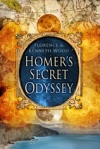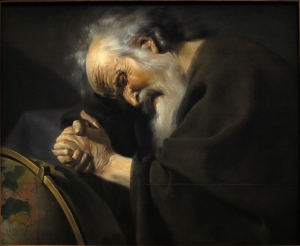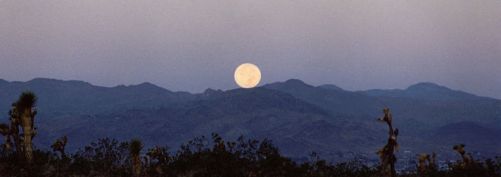The winter solstice inspires many column inches of popular coverage ranging from the scientific to the magical and the mysterious. The solstice on December 21, 2017, was no exception.
There was also on that day, however, an astronomical event that occurs only every 19 years but is so significant in calendrical terms that it was known to astronomers in Ancient Greece more than 2500 years ago.
Indeed, so familiar was the poet-astronomer Homer with such a cyclical occurrence that he made it the 19-year time-span of his epic works, the Iliad and the Odyssey.
While there is no certainty about when Homer lived, scholars have suggested it may have been during the period 800 BC to 650 BC.
The event
At the winter solstice on December 21, 2017, a new crescent moon appeared in the skies of the northern hemisphere shortly before sunset.
The previous sighting of a new crescent moon at a winter solstice had occurred 19 years earlier on December 21, 1998.
And the next appearance of a new crescent moon at a winter solstice will be in 19-years time on December 21, 2036.
Meton and the 19-year luni-solar cycle
Such a cycle is commonly attributed to Meton of the Fifth Century BC who is remembered ‘for calculations involving the eponymous 19-year Metonic cycle which he introduced in 432 BC into the lunisolar Attic calendar. Scholars, however, have indicated that the 19-year luni-solar cycle was used for calendrical purposes in other cultures long before Meton or even Homer.
During a cycle of 19 solar years there are 235 lunations, or synodic months, after which the Moon’s phases recur on the same days of the solar year.
In visible terms, this meant for Homer that the appearance of a new crescent moon at a winter solstice marked the end of one 19-year luni-solar cycle and the beginning of the next.
Homer’s knowledge and use of the cycle may suggest that Meton provided a scientific and mathematical exposition of a cycle that had been known in terms of accurate practical use in much earlier centuries when the Greeks did not have a writing system.
Homer’s Odyssey
Although a 19-year luni-solar cycle is the time frame of both the Iliad and the Odyssey it is in the Odyssey[1] alone that Homer expounds upon luni-solar cycles of four (an Olympiad), eight and nineteen years, an eight-year cycle of planet Venus, and constructs a detailed annual luni-solar calendar system.
So precise is Homer’s narrative and embedded mathematical data, that he was able to record in allegorical prose that the Iliad-Odyssey 19-year cycle began at a new crescent moon in the late afternoon at a winter solstice and ended 19 years later .
In terms of Homer’s discourse on luni-solar cycles and calendar-making, the Odyssey is very complex and the parameters of the 19-year luni-solar cycle are only first disclosed in Book 19 when disguised Odysseus meets his wife after almost 19 years away.
Penelope, conveniently, does not recognize her husband but recalls how Odysseus was dressed on leaving home to fight at Troy in terms that project allegorical imagery of a new crescent moon at midwinter. Her farewell gift to Odysseus, she remembers, was a brooch that creates an image of a new crescent moon.
This curious reunion takes place at dark of moon and on the following afternoon and the rise of a new crescent moon, Odysseus is revealed as a vengeful warrior who destroys the suitors besieging his lonely wife.
An earlier intimation of Odysseus’s lunar role is expressed in Homer’s account of his hero’s return to Ithaca in early morning when the last sighting of an old crescent moon can be seen. In the following dark period Odysseus is disguised as a beggar and generally not recognized … except when he reveals himself to friends. These brief periods not only have literary value but may also affirm the variable length of the lunar dark period.
Homer also sets the time of year in Ithaca as midwinter when he notes ‘the weather is foul and raining’ and Eumaeus declares ‘the nights are very long…’ (Od.15.392).
Homer’s gory descriptions, with numerical enhancements (see Endnote below), of the slaughter of the suitors and maidservants, brings Homer’s treatise on a sophisticated calendar system and luni-solar cycles to an unforgettable climax.
The ending of the Odyssey is relatively low key: Following the slaying of the suitors, Odysseus spends only one night with Penelope before going to visit his aged father, an icon of an earlier 19-year cycle. He then embarks on a quest to discover a land where the natives believe that the oar he is carrying is a winnowing shovel. To Homer’s audiences of sea-faring Greeks that quest, like time and the 19-year luni-solar cycle itself, would be never ending.
Endnote: In the Odyssey, Homer lists 118 suitors and their servants; 118 is also the number of days in four lunar months or one lunar ‘season’ (the Greek year had three seasons: spring, summer and winter). Overall, Homer invokes the number 118 on three occasions: 3 x 118 = 354 days in a lunar year.
Homer did not use fractions and to accommodate the 29.53 days of the lunar month, he alternated 29-day ‘hollow’ months with 30-day ‘full’ months, giving an average of 29.5 days. These calculations are based on numerical data embedded in the Odyssey. See ‘Homer’s Wizardry with Numbers’ (HSO p 62 ff), and elsewhere in HSO
2018 K and FS Wood
[1] See Homer’s Secret Odyssey (The History Press, 2011); Homer’s Secret Iliad (John Murray, 1999).






